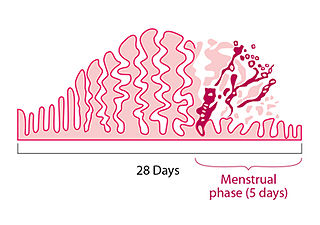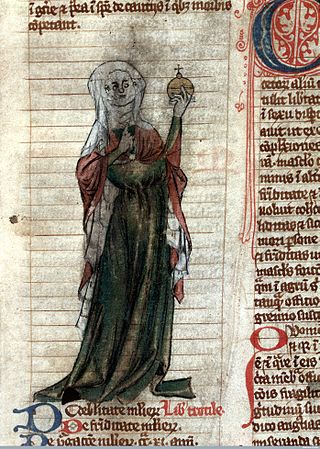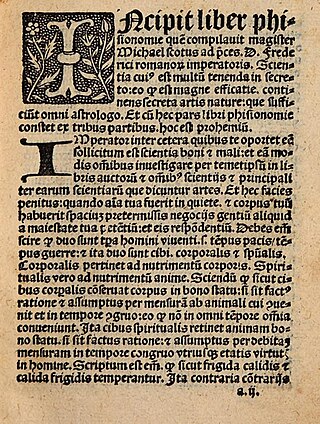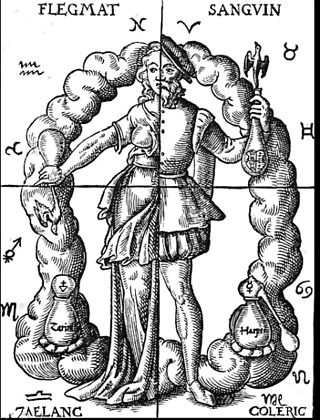
Albertus Magnus, also known as Saint Albert the Great, Albert of Swabia or Albert of Cologne, was a German Dominican friar, philosopher, scientist, and bishop.

Menstruation is the regular discharge of blood and mucosal tissue from the inner lining of the uterus through the vagina. The menstrual cycle is characterized by the rise and fall of hormones. Menstruation is triggered by falling progesterone levels and is a sign that pregnancy has not occurred.

The menstrual cycle is a series of natural changes in hormone production and the structures of the uterus and ovaries of the female reproductive system that makes pregnancy possible. The ovarian cycle controls the production and release of eggs and the cyclic release of estrogen and progesterone. The uterine cycle governs the preparation and maintenance of the lining of the uterus (womb) to receive an embryo. These cycles are concurrent and coordinated, normally last between 21 and 35 days, with a median length of 28 days, and continue for about 30–45 years.

The Index Librorum Prohibitorum was a changing list of publications deemed heretical or contrary to morality by the Sacred Congregation of the Index ; Catholics were forbidden to print or read them, subject to the local bishop. Catholic states could enact laws to adapt or adopt the list and enforce it.

Embryology is the branch of animal biology that studies the prenatal development of gametes, fertilization, and development of embryos and fetuses. Additionally, embryology encompasses the study of congenital disorders that occur before birth, known as teratology.

Trotula is a name referring to a group of three texts on women's medicine that were composed in the southern Italian port town of Salerno in the 12th century. The name derives from a historic female figure, Trota of Salerno, a physician and medical writer who was associated with one of the three texts. However, "Trotula" came to be understood as a real person in the Middle Ages and because the so-called Trotula texts circulated widely throughout medieval Europe, from Spain to Poland, and Sicily to Ireland, "Trotula" has historic importance in "her" own right.
Premenstrual dysphoric disorder (PMDD) is a mood disorder characterized by emotional, cognitive, and physical symptoms. PMDD causes significant distress or impairment in menstruating people during the luteal phase of the menstrual cycle. The symptoms occur in the luteal phase, improve within a few days after the onset of menses, and are minimal or absent in the week after menses. PMDD has a profound impact on a person's quality of life and dramatically increases the risk of suicidal ideation and even suicide attempts. Many women of reproductive age experience discomfort or mild mood changes prior to menstruation. However, 5–8% experience severe premenstrual syndrome causing significant distress or functional impairment. Within this population of reproductive age, some will meet the criteria for PMDD.

The female reproductive system is made up of the internal and external sex organs that function in the reproduction of new offspring. The human female reproductive system is immature at birth and develops to maturity at puberty to be able to produce gametes, and to carry a fetus to full term. The internal sex organs are the vagina, uterus, fallopian tubes, and ovaries. The female reproductive tract includes the vagina, uterus, and fallopian tubes and is prone to infections. The vagina allows for sexual intercourse and childbirth, and is connected to the uterus at the cervix. The uterus or womb accommodates the embryo which develops into the fetus. The uterus also produces secretions which help the transit of sperm to the fallopian tubes, where sperm fertilize ova produced by the ovaries. The external sex organs are also known as the genitals and these are the organs of the vulva including the labia, clitoris, and vaginal opening.

The Emerald Tablet, also known as the Smaragdine Tablet or the Tabula Smaragdina, is a compact and cryptic Hermetic text. It was highly regarded by Islamic and European alchemists as the foundation of their art. Though attributed to the legendary Hellenistic figure Hermes Trismegistus, the text of the Emerald Tablet first appears in a number of early medieval Arabic sources, the oldest of which dates to the late eighth or early ninth century. It was translated into Latin several times in the twelfth and thirteenth centuries. Numerous interpretations and commentaries followed.
In obstetrics, gestational age is a measure of the age of a pregnancy taken from the beginning of the woman's last menstrual period (LMP), or the corresponding age of the gestation as estimated by a more accurate method, if available. Such methods include adding 14 days to a known duration since fertilization, or by obstetric ultrasonography. The popularity of using this measure of pregnancy is largely due to convenience: menstruation is usually noticed, while there is generally no convenient way to discern when fertilization or implantation occurred.

A menstrual disorder is characterized as any abnormal condition with regards to a woman's menstrual cycle. There are many different types of menstrual disorders that vary with signs and symptoms, including pain during menstruation, heavy bleeding, or absence of menstruation. Normal variations can occur in menstrual patterns but generally menstrual disorders can also include periods that come sooner than 21 days apart, more than 3 months apart, or last more than 10 days in duration. Variations of the menstrual cycle are mainly caused by the immaturity of the hypothalamic-pituitary-ovarian (HPO) axis, and early detection and management is required in order to minimize the possibility of complications regarding future reproductive ability.

There are many cultural aspects surrounding how societies view menstruation. Different cultures view menstruation in different ways. The basis of many conduct norms and communication about menstruation in western industrial societies is the belief that menstruation should remain hidden. By contrast, in some hunter-gatherer societies, menstrual observances are viewed in a positive light, without any connotation of uncleanness.
Albertus Magnus produced the Speculum Astronomiae sometime after 1260 to defend astrology as a Christian form of knowledge. Though Albert's authorship of this text has been debated by such scholars as Pierre Mandonnet and, more recently, Nicholas Weill-Parot, some scholars recognized it as a genuinely Albertine work.
Menstruation is the shedding of the uterine lining (endometrium). It occurs on a regular basis in uninseminated sexually reproductive-age females of certain mammal species.
Philipp Ulstad was a nobleman from Nuremberg, who taught medicine at the academy in Fribourg at the beginning of the sixteenth century.

Liber physiognomiae is a work by the Scottish mathematician, philosopher, and scholar Michael Scot concerning physiognomy; the work is also the final book of a trilogy known as the Liber introductorius. The Liber physiognomiae itself is divided into three sections, which deal with various concepts like procreation, generation, dream interpretation, and physiognomy proper.

The Grand Albert is a grimoire that has often been attributed to Albertus Magnus. Begun perhaps around 1245, it received its definitive form in Latin around 1493, a French translation in 1500, and its most expansive and well-known French edition in 1703. Its original Latin title, Liber Secretorum Alberti Magni virtutibus herbarum, lapidum and animalium quorumdam, translates to English as "the book of secrets of Albert the Great on the virtues of herbs, stones and certain animals". It is also known under the names of The Secrets of Albert, Secreta Alberti, and Experimenta Alberti.
Modern historians' knowledge of ancient Roman gynecology and obstetrics primarily comes from Soranus of Ephesus' four-volume treatise on gynecology. His writings covered medical conditions such as uterine prolapse and cancer and treatments involving materials such as herbs and tools such as pessaries. Ancient Roman doctors believed that menstruation was designed to rid the female body of excess fluids. They believed that menstrual blood had special powers. Roman doctors may also have noticed conditions such as premenstrual syndrome.

Many beliefs amount menstruation in the early modern period were linked to humorism, the system of medicine introduced by Ancient Greek and Roman physicians. People believed that the human body contained four humours: blood, phlegm, yellow bile, and black bile. Illnesses and problems were understood as being caused by dyscrasia, or an imbalance in the four humours. Treatments for disease had the aim of restoring a balance, curing the patient. The humoral model was a continuity during the early modern period, despite the fact that new medical theories began to arise in the second half of the eighteenth century, because these new ideas which used different treatments involving new chemicals were not as trusted since they were not properly established.
Jewish male menstruation is the belief that Jewish males experience menstrual periods, or periodic bleeding. This belief was popular among Christians across Europe throughout the late medieval and early modern period, including in Great Britain, Germany, and Spain. Common ways Jewish men supposedly menstruated were through nosebleeds, urination, and bleeding of hemorrhoids. The ability to menstruate was not associated with having a uterus. The first written mention of this phenomenon was in Jacques de Vitry’s Historia Orientalis in 1219. These attitudes have roots in both Humorism and religious, antisemitic Christian beliefs.











